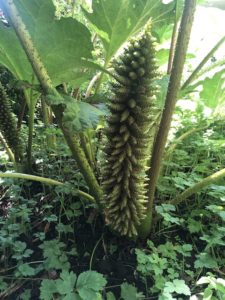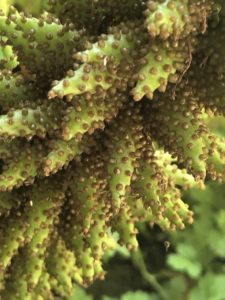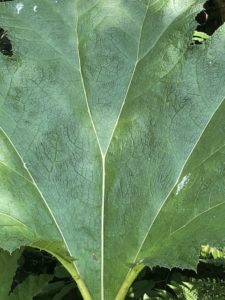Wild Thing – Living with my Gunnera manicata
by Lisa Reddick
It’s July. Today it’s raining. Not the best weather for us, but my Gunnera plant is having a great time. Unaware of the pandemic, the wet, warm spring and summer has served up the best days for my Gunnera to thrive. This year the leaves are bigger than ever, reaching almost 3 feet across and almost 6 feet tall! What a plant. I’ve always admired its jungle-like, exotic appeal and it seeming tenacity to come through most of our winters just fine.
Nestled on the bank of the stream that flows through our property and shaded by our towering willows, our Gunnera is in a perfect place. When we designed the garden, I did agree to a few plants that weren’t edibles and this was one. It didn’t seem ominous at first, each year the leaves reaching from the soil like large green hands, and then opening wide and stretching out toward the summer sky. The flower then blooms and arches over the root ball, and I sometimes wonder if a Triceratops is going to come from behind our fence for a bite. One of the nicknames for Gunnera is dinosaur food! Another popular nickname is Brazilian Rhubarb but there is no relationship between the two species, just a leaf look-alike on a very different scale.

Flower of the Gunnera manicata
The Gunner manicata is a mysterious plant that is native to the southern hemisphere. Our winters can be hard on them. The year we had snowmageddon, that spring my Gunnera was merely a handshake and not the full thrusting dark green cheer that it is this year. Each fall I let the large leaves drape over the root ball, and so far that has been all that it needs to get through the winter.
I decided to spend some time getting to know my large friend, and did some research. According to the Oxford herbaria, the Gunnera is an ancient species dating more than 150 million years old. It is one of the only angiosperms that creates a symbiotic relationship with a cyanobacteria called Nostoc, or blue-green algae. This takes place in the intercellular spaces on the stem or petioles. What’s cool about this is that it is one of the only nitrogen fixing single-cell bacteria relationships like this, and it’s only with the plant Gunnera - and it’s happening in my backyard.

Close up of the flower nodules of the Gunnera.
It’s so much fun to discover all the relationships in our gardens, landscapes, and all the wild lands around us. We can learn so much about the big picture when we take the time to focus on one plant, one story, growing next to the stream in our garden. The beautiful dendritic patterns of the Gunnera leaves reflect the many branches of the willows overhead and the meandering stream below. As I spend more time wondering about this important relationship, I become humble in the garden, where I am a participant in a dance of light, darkness, abundance and grace that I am immensely grateful for.


